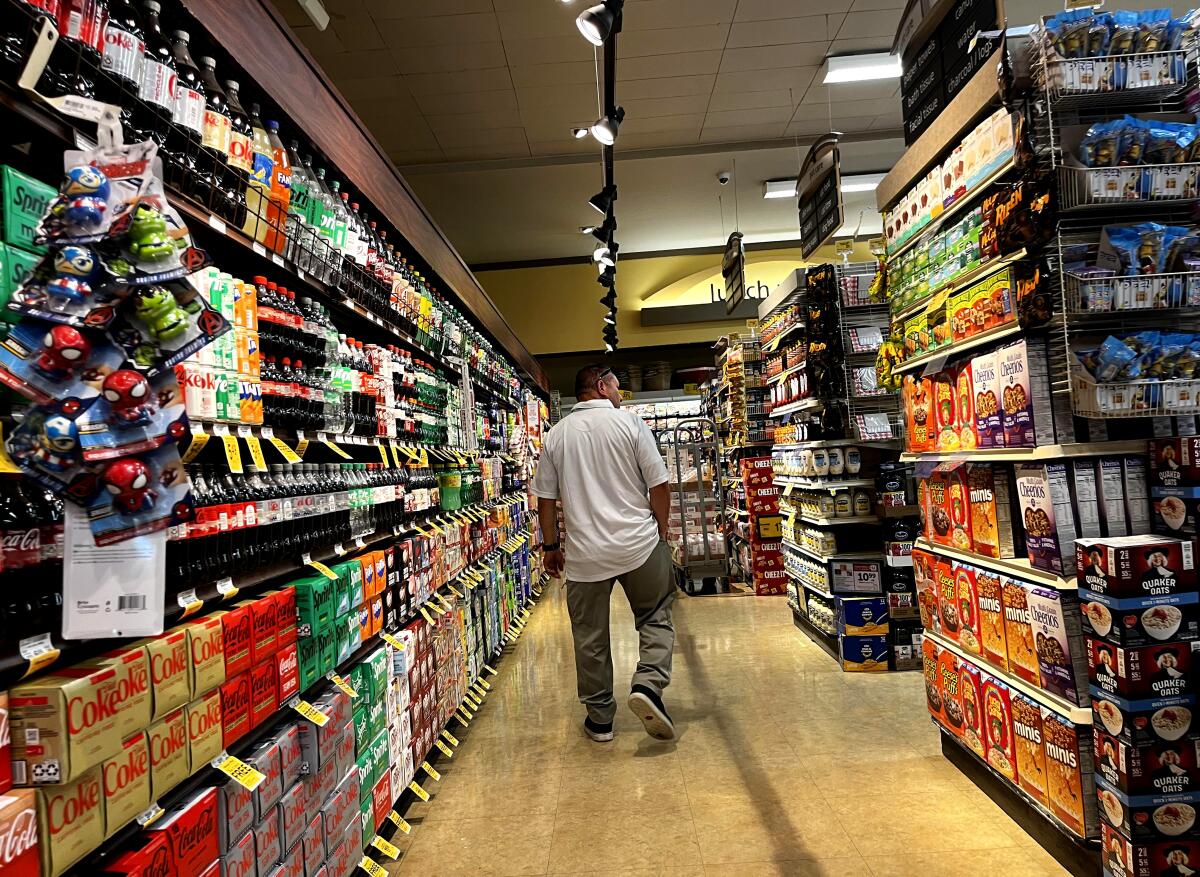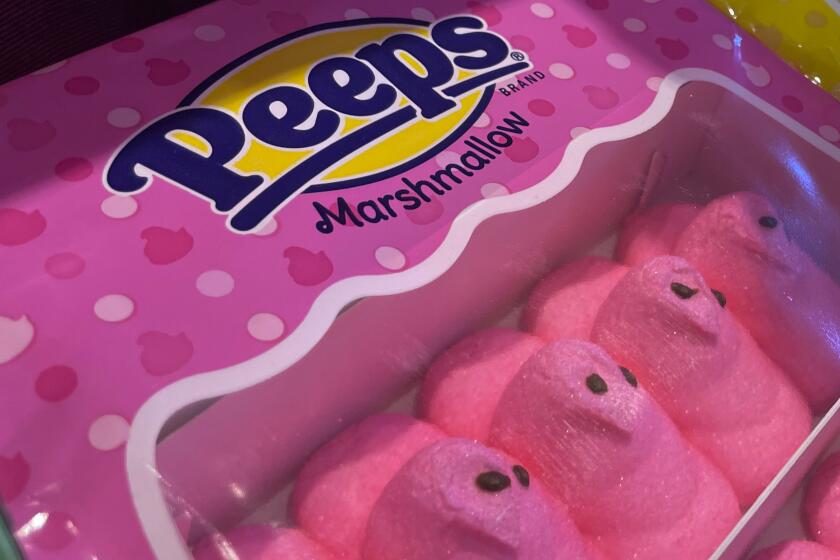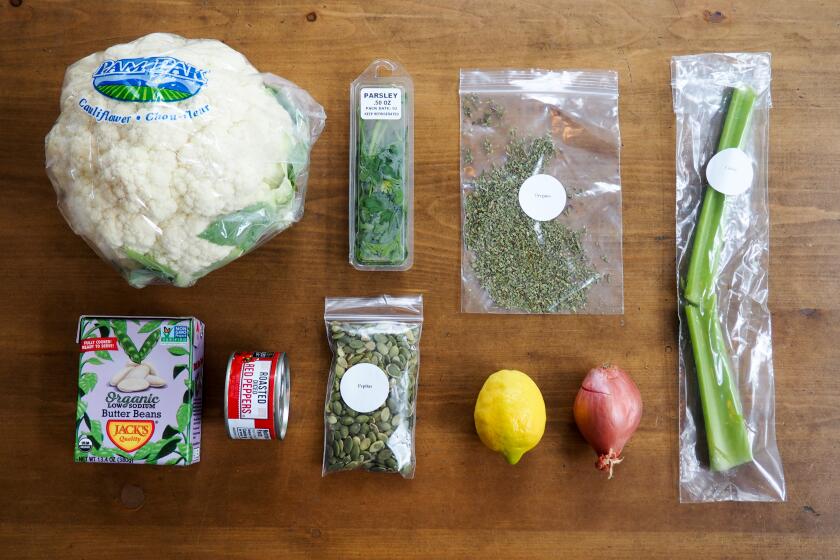How the FDA allows companies to add secret ingredients to our food

- Share via
It’s a Food and Drug Administration rule that most Americans know little about, yet gives corporations the license to add potentially harmful ingredients to foods without regulatory oversight or public notice.
For decades, the FDA’s “generally recognized as safe,” or GRAS, designation has allowed food makers to decide for themselves whether certain novel ingredients are safe or not — even without providing evidence to agency scientists.
Consumer advocates say the system has allowed companies to add harmful chemicals, including suspected carcinogens, to such products as cereals, baked goods, ice cream, potato chips and chewing gum.
Now, President-elect Donald Trump’s nomination of Robert F. Kennedy Jr. to lead the Department of Health and Human Services promises to elevate the issue. Although Kennedy’s penchant for amplifying medical conspiracies and his anti-vaccination activism have alarmed many public health experts, his vow to crack down on chemical additives in food has resonated with consumer health advocates.
The anti-vaccine activist could oversee the Centers for Disease Control and Prevention, the Food and Drug Administration and the National Institutes of Health.
The problem, critics say, is that a GRAS determination is supposed to follow a scientific assessment, ideally one conducted by independent experts.
Under the law, however, it is entirely optional for companies to share their assessments with FDA reviewers. That means the FDA and American consumers are in the dark about hundreds of compounds in processed foods.
“FDA cannot ensure the safety of our food supply if it does not know what is in our food,” said Thomas Galligan, principal scientist for food additives and supplements at the Center for Science in the Public Interest.
When the agency does learn about a new compound, it evaluates the company’s safety report to see whether it agrees. If FDA scientists see problems and request additional information, the company doesn’t have to provide it. It can simply withdraw its GRAS notice and use the ingredient anyway.
Natalie Mihalek, a former prosecutor and current state legislator in Pennsylvania, said she doesn’t understand why the FDA treats food additives like criminal defendants — “innocent until proven guilty, safe until proven otherwise.”
“Right now we’re relying on the companies that are going to profit off selling these substances to do the research for us,” said Mihalek, a Republican who has introduced a bill to ban six food dyes in her state. “It just blows my mind.”
FDA officials acknowledge the limits of the GRAS system but say they don’t have the authority to change it.
“Congress sets GRAS as part of the law,” said Kristi Muldoon Jacobs, director of the FDA’s Office of Food Additive Safety. “It is our responsibility to administer the law. We do not in fact have the authority to make the laws.”
Concern about the safety and purity of food prompted Congress to pass the Food and Drugs Act in 1906, just months after Upton Sinclair brought the meatpacking industry’s unsanitary practices to light in his book “The Jungle.” The new law forbade the manufacture and sale of foods that were “adulterated or misbranded or poisonous.”
The FDA’s regulatory powers expanded in 1938 with the passage of the Food, Drug and Cosmetic Act, and a 1958 amendment divided food ingredients into two categories: additives that must be assessed for safety, and substances that could go straight into foods because they are “generally recognized as safe.”
Unfortunately, the legal distinction between the two kinds of ingredients is “very vague,” said Jennifer Pomeranz, a public health lawyer at New York University’s School of Global Public Health.
Gov. Gavin Newsom has signed the nation’s first law banning four “toxic” chemical food additives found in popular drinks, baked goods, candy and snacks.
The types of ingredients that were considered GRAS in 1958 included items that were already in wide use, such as salt, vanilla extract, baking powder and vinegar.
The FDA established a list of GRAS substances and added new items if they passed a safety review. Individuals from outside the agency also could ask to have a particular substance studied for inclusion on the official GRAS list.
But the process was time-consuming, and petitions from industry could take six years or more to evaluate. As part of the Clinton-era initiative to streamline government operations, the FDA embraced a newer, faster system designed to make it more enticing for companies to keep the agency in the loop about their GRAS decisions. Now the FDA pledges to respond to GRAS notices within 180 days.
The notification process is also low-risk for food companies.
If everything looks good, the FDA says it has “no questions” about the compound, effectively endorsing the GRAS assessment. This happens about 80% of the time, according to researchers Thomas Neltner and Maricel Maffini, who analyzed notices filed with the agency.
If things aren’t so clear, the agency may say it needs more information before it can weigh in. And if a company decides not to provide that information, it can back out of the process and the FDA will say it ended its evaluation at the filer’s request.
Such was the case with an ingredient in Sleepy Chocolate.
Not just another gourmet candy bar, the dark chocolate with lavender and blueberry flavors is infused with the hormone melatonin, the amino acid L-tryptophan, a blend of soothing botanicals and something called PharmaGABA, an artificial version of a neurotransmitter that calms the brain.
PharmaGABA is made by Pharma Foods International Co. of Kyoto, Japan. The company touts its product as having “US-FDA’s self-affirmed GRAS approval” even though the FDA twice raised serious concerns about its safety and has never indicated to the public that its misgivings were addressed.
Nothing about this violates the law.
A California ban on red dye No. 3, titanium dioxide and other chemicals found in thousands of food items would be the first among the states.
Neltner, a chemical engineer and attorney, and Maffini, a biochemist and consultant, dug into the FDA’s files on PharmaGABA to see why regulators were concerned about it.
In its initial notice filed in 2008, Pharma Foods said it hired a Canadian consulting firm to determine whether PharmaGABA should qualify for GRAS status when used in candy, chewing gum, beverages and other products.
The consulting firm produced a report about the product and tapped three university professors with expertise in pharmacology, toxicology and food science to weigh in. The trio’s determination that the product was “safe and suitable and would be GRAS” was unanimous, according to the filing.
Yet after reviewing all 155 pages of the PharmaGABA notice, FDA scientists raised concerns about the product’s purity, its risk for causing low blood pressure and electrolyte imbalances, and the lack of data on how PharmaGABA is metabolized, among other problems.
Pharma Foods withdrew its notice, and the FDA ended its evaluation.
The company tried again in 2015 with a GRAS notice for using PharmaGABA in yogurts and cheese, cereals and snack bars, candy and gum, and an array of beverages including sports drinks and flavored milks. The same consulting firm assembled a scientific panel that said consuming PharmaGABA in expected quantities was “reasonably expected to be safe.”
As before, FDA reviewers had concerns. They said the new filing didn’t back the company’s claims that the product would be absorbed into the bloodstream at low levels and that it wouldn’t cross the blood-brain barrier. The reviewers were particularly concerned with the compound’s potential to harm pregnant women and children, as well as its effect on the pituitary gland.
Pharma Foods withdrew its notice so it could “conduct further studies,” and the FDA ceased its second evaluation of the product.
The common food dyes — blue 1, blue 2, green 3, red 40, yellow 5 and yellow 6 — have been linked to developmental and behavioral harms in children, according to the California Environmental Protection Agency.
Maffini said it wasn’t unusual for agency scientists to find fault with GRAS decisions that passed muster with hired consultants. Giving their clients favorable reviews increases their chances of being hired again, she said.
Nine years later, Pharma Foods has yet to share additional results with the FDA. But PharmaGABA legally remains in Sleepy Chocolate based on Pharma Foods’ determination that the compound should be generally recognized as safe.
Pharma Foods International and Functional Chocolate Co., which makes Sleepy Chocolate, did not respond to requests to discuss PharmaGABA’s safety.
Maffini said she was frustrated that the FDA scientists who examined PharmaGABA couldn’t post a memo to warn the public about their concerns. (She and Neltner obtained the GRAS documents by filing a Freedom of Information Act request.)
“They ask questions,” Maffini said of the agency scientists, “but then there’s really nothing they can do.”
For every ingredient like PharmaGABA that is disclosed to the FDA, another probably makes its way to the market without any regulatory review.
By definition, there’s no way to know for sure how many new additives are granted GRAS status in secret. To make an estimate, researchers scoured websites and trade journals to find every corporate announcement of a new GRAS product during an eight-week period. Ten of those products weren’t on the FDA’s GRAS notice list.
If those eight weeks were typical, at least 65 new substances are being introduced into the food supply every year without any vetting by the agency. That’s on a par with the 60 to 70 GRAS notices that Muldoon Jacobs said the FDA evaluates each year.
The situation is something of a catch-22, Pomeranz said: Since GRAS products are presumed to be safe, they aren’t subject to regulatory review. But since they’re not regulated, how can the public be assured that they’re safe?
And that’s only part of the problem, she said. When companies use novel ingredients, they can list them on food labels using generic terms like “flavors” or “colors.” That makes it all but impossible for consumers to know that something new has been added to their food, she said.
This helps explain how an ingredient called tara flour was able to sicken hundreds of people who consumed French Lentil + Leek Crumbles, a meat replacement product sold by Daily Harvest, in 2022. Customers suffered severe abdominal pain, fever, chills and acute liver failure, and more than 100 were hospitalized, according to the FDA. The company issued a voluntary recall and blamed a compound in tara flour for the illnesses.
Here are a few strategies that experts and food safety officials recommend to ensure that meal-kit supplies and ready-to-heat meals are safe to eat.
Tara flour is a high-protein substance made from the seeds of an evergreen tree found in South America. There is no GRAS notice for the ingredient in the FDA’s database. Tests conducted after the outbreak found that an amino acid in the flour caused liver damage in mice.
In May, nearly two years after the recall, the FDA concluded that tara flour doesn’t meet the scientific standard to qualify for GRAS status. That makes it an unapproved food additive and is considered unsafe.
The agency added that it’s not aware of any products made in the U.S. that contain tara flour, nor has it identified any imported products that contain the ingredient.
The case shows why the FDA’s regulatory approach needs to change, said Jensen N. Jose, regulatory counsel for food chemical safety at the Center for Science in the Public Interest.
“Self-declaring that your chemical is safe should not be the law of the land,” Jose said. “I highly doubt that’s what Congress meant” when it created the GRAS designation in 1958, he said.
Bills introduced in the U.S. House and Senate would put an end to the practice of allowing companies to make GRAS determinations in secret. The legislation would require companies to share their scientific reviews and give the FDA and the public at least 90 days to review — and potentially challenge — them before they take effect, among other provisions.
But both bills have a ways to go in order to pass before the congressional term ends in January.
The safety of mass-produced food has improved dramatically in recent decades, but listeria, a common type of bacterium, presents unique hurdles.
Jose has another idea for reducing the secrecy surrounding novel food ingredients: Require companies using self-declared GRAS ingredients to submit the safety data to the New York Department of Agriculture and Markets in Albany as a condition for selling their products in the Empire State.
Jose laid out the plan in a bill that is under consideration in the New York state Legislature. If it passes, state regulators would not be required to review the safety data, but at least it would become publicly available, he said.
“The goal is that you’d have a database so if something like tara flour happens, the FDA can look there and be able to respond more quickly,” Jose said.
Companies could avoid the notification requirement by keeping their products out of New York stores, but that would be a tip-off to watchdog groups like his, Jose said.
“If we find them selling everywhere except New York, we’ll know there might be something wrong with this chemical,” he said.
Jim Jones, the FDA’s deputy commissioner for human foods, has acknowledged the “growing public demand for the FDA to do more to ensure the safety of chemicals currently in the U.S. food supply.”
California and other states have sought to fill the void by regulating or banning select food additives within their borders. But “a strong national food-safety system is not built state-by-state,” Jones said. “The FDA must lead the way.”













